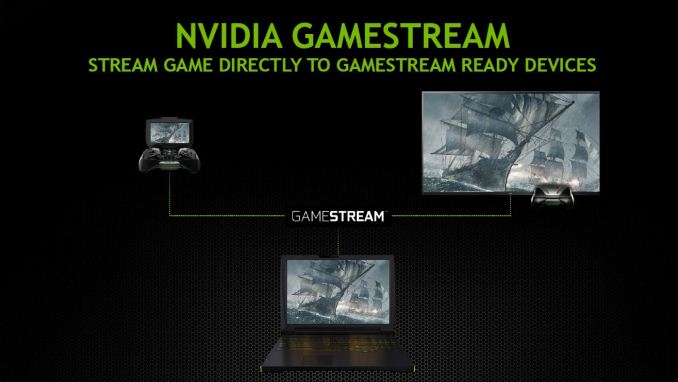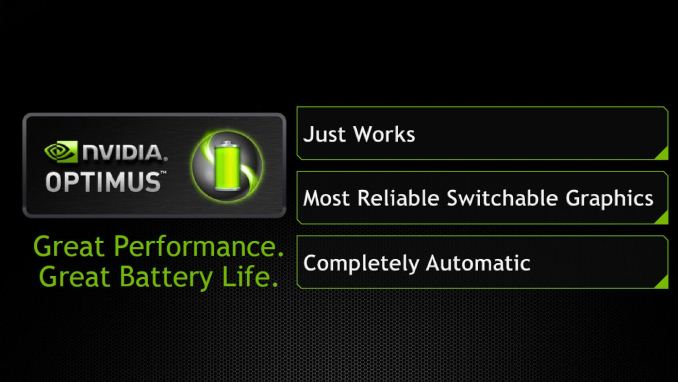NVIDIA’s GeForce 800M Lineup for Laptops and Battery Boost
by Jarred Walton on March 12, 2014 12:00 PM ESTOther Features: GameStream, ShadowPlay, Optimus, etc.
Along with Battery Boost, the GTX class of 800M GPUs will now also support NVIDIA’s GameStream and ShadowPlay technologies, again through NVIDIA’s GeForce Experience software. Unlike Battery Boost, these are almost purely software driven solutions and so they are not strictly limited to 800M hardware. However, the performance requirements are high enough that NVIDIA is limiting their use to GTX GPUs, and all GTX 700M and 800M parts will support the feature, along with the GTX 680M, 675MX, and 670MX. Basically, all GTX Kepler and Maxwell parts will support GameStream and ShadowPlay; the requirement for Kepler/Maxwell incidentally comes because GameStream and ShadowPlay both make use of NVIDIA’s hardware encoding feature.
If you haven’t been following NVIDIA’s software updates, the quick summary is that GameStream allows the streaming of games from your laptop/desktop to an NVIDIA SHIELD device. Not all games are fully supported/optimized, but there are over 50 officially supported games and most Steam games should work via Steam’s Big Picture mode. I haven’t really played with GameStream yet, so I’m not in a position to say much more on the subject right now, but if you don’t mind playing with a gamepad it’s another option for going mobile – within the confines of your home – and can give you much longer unplugged time. GameStream does require a good WiFi connection (at least 300Mbps 5GHz, though you can try it with slower connections I believe), and the list of GameStream-Ready routers can be found online.
On a related note, something I'd really like to see is support for GameStream extended to more than just SHIELD devices. NVIDIA is already able to stream 1080p content in this fashion, and while it might not match the experience of a GTX 880M notebook running natively, it would certainly be a big step up from lower-end GPUs and iGPUs. Considering the majority of work is done on the source side (rendering and encoding a game) and the target device only has to decode a video stream and provide user I/O, it shouldn't be all that difficult. Take it a step further and we could have something akin to the GRID Gaming Beta coupled with a gaming service (Steam, anyone?) and you could potentially get five or six hours of "real" gaming on any supported laptop! Naturally, NVIDIA is in the business of selling GPUs and I don't see them releasing GameStream for non-NVIDIA GPUs (i.e. Intel iGPUs) any time soon, if ever. Still, it's a cool thought and perhaps someone else can accomplish this. (And yes, I know there are already services that are trying to do cloud gaming, but they have various drawbacks; being able to do my own "local cloud gaming" would definitely be cool.)
ShadowPlay targets a slightly different task, namely that of capturing your best gaming moments. When enabled in GFE, at any point in time you can press Alt+F10 to save up to the last 20 minutes (user configurable within GFE) of game play. Manual recording is also supported, with Alt+F9 used to start/stop recording and a duration limited only by the amount of disk space you have available. (Both hotkeys are customizable as well.) The impact on performance with ShadowPlay is typically around 5%, and at most around 10%, with a maximum resolution of up to 1080p (higher resolutions will be automatically scaled down to 1080p).
We’ve mentioned GeForce Experience quite a few times now, and NVIDIA is particularly proud of all the useful features they’ve managed to add to GFE since it first went into open beta at the start of 2013. Initially GFE’s main draw was the ability to apply “optimal” settings to all supported/detected games, but obviously that’s no longer the only reason to use the software. Anyway, I’m not usually much of a fan of “automagic” game settings, but GFE does tend to provide appropriate defaults, and you can always adjust any settings that you don’t agree with. AMD is trying to provide a similar feature via their Raptr gaming service, but by using a GPU farm to automatically test and generate settings for all of their GPUs NVIDIA is definitely ahead for the time being.
NVIDIA being ahead of AMD applies to other areas as well, to varying degrees. Optimus has seen broad support for nearly every laptop equipped with an NVIDIA GPU for a couple years now, and the number of edge cases where Optimus doesn’t work quite as expected is quite small – I can’t remember the last time I had any problems with the feature. Enduro tends to work okay on the latest platforms as well, but honestly I haven’t received a new Enduro-enabled laptop since about a year ago, and there have been plenty of times where Enduro – and AMD’s drivers – have been more than a little frustrating. PhysX and 3D Vision also tend to get used/supported more than the competing solutions, but I’d rate those as being less important in general.













91 Comments
View All Comments
JarredWalton - Thursday, March 13, 2014 - link
I've never been much of a fan of SLI in laptops. Scaling is never perfect, often there is more difficulty with drivers and game compatibility, and battery life can take a hit as well. I mentioned it didn't support SLI, but I can't say it bothers me much. 860M Maxwell supports it (apparently) and will use the same chip, so really it's only going to be a small bump in price to go from two 850M to two 860M -- assuming an OEM wants to do SLI 860M that is.Harmattan - Wednesday, March 12, 2014 - link
I think the thesis of this article is right on: it's a great time for gaming notebooks. The idea just four years ago that I could play the newest games at highest settings at 2560x1600 at more than respectable FPS was unthinkable. My Sager with dual 780ms does that with legs to spare, and I should be able to do this with a SINGLE GPU once high-end Maxwell mobile chips come later this year -- simply amazing.IntelUser2000 - Thursday, March 13, 2014 - link
"we’re talking about a feeble 16GB/s of memory bandwidth – that’s lower than what most desktops and laptops now have for system memory, as DDR3-1600 with a 128-bit interface will do 25.6GB/s."Actually the shared aspect in iGPU systems effectively makes the bandwidth equal to about half that. That is, 12.8GB/s.
JarredWalton - Thursday, March 13, 2014 - link
Only if you're using the iGPU to do something, but since I'm discussing system bandwidth vs. GPU bandwidth I didn't get into that. I suppose something like Kaveri will end up with about the same 16GB/s of bandwidth from the system RAM (with the remaining bandwidth going to the CPU), but really Kaveri will still only be a "moderate" GPU performance level.lmcd - Thursday, March 13, 2014 - link
Since when has Fermi been die shrunk? The 820 needs fact-checked.Ryan Smith - Thursday, March 13, 2014 - link
Since 2012. They released a 28nm version of GF108: GF117.http://www.anandtech.com/show/5697/nvidias-geforce...
jasonelmore - Thursday, March 13, 2014 - link
First Maxwell SLI Enabled GPU!!! and its in a LAPTOP WTFfteoath64 - Thursday, March 13, 2014 - link
Does anybody see why Maxwell part is the starting point and Kepler holding the higher end of the range ?. They are squeezing blood out of Kepler before a complete switch to Maxwell. It is a very clever trick to pull and buys NV time to carefully craft the performance of higher end Maxwell parts to suit the performance/price model they wanted. This release alone seems enough to maintain their discrete gpu market on laptops while AMD struggles with their mobile market. It keeps Intel IGP at bay except for non gamers who do not care about discrete graphics.hero4hire - Thursday, March 13, 2014 - link
I am one of those people that think laptop gaming "is a joke" still. 1hr gaming is still limited but more so is most gamers are going to want to use a mouse not trackpad and therefore use a table. At the point you're gaming at a table why not build a solid desktop and buy an ultraportable for less? Are people unable to spend a 1k to 2k budget better in this regard?I am greatful to see real performance hitting laptops, lower 850m = 580m in the illustration for example. Coming from a purely cost sense I am unconvinced an upgradable desktop and cheap slim low power laptop is not better for the vast majority while also being cheaper. Especially in the long run as you can upgrade a desktop while a $200-$300 laptop won't depreciate like a 1k-2k one will. For example, who is going to buy that 580m laptop for even half its list now? A cheap laptop is almost always worth $100.
lordmocha - Sunday, March 16, 2014 - link
most play plugged into the power and with an external mouseyet the reason to get a gaming laptop (not gaming desktop + laptop) is that it can be cheaper (though performance will be worse), and that it is very portable to take to a friends house